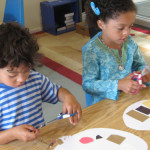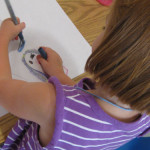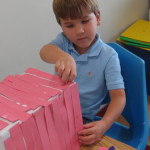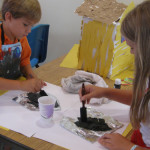I’ve been volunteering with curator Sara Arnold for a couple of years, and I’ve been able to work on a variety of interesting projects. I have helped document the Alfred Hutty print inventory, update catalogue records for publication on the museum’s website, research French miniature painters in America for the In Search of Julien Hudson exhibit, write information sheets for docent training, along with many other tasks around the curatorial department. When Sara asked if I would be interested in working with the summer art camp, I readily agreed and looked forward to seeing kids express their creativity and learn more about the fabulous collection at the Gibbes. The campers certainly didn’t disappoint.
Above: Campers created artist palettes and miniature portraits.
The first session was all about portraiture, and my favorite project was creating miniature “paintings.” While visiting the galleries, the campers were amazed to see the miniature portrait collection, and were even more surprised to learn that artists used single-hair brushes to complete such small masterpieces. We used Shrinky Dinks paper and markers (a much easier tool!) to draw small portraits, and after they “cooked” they were tiny! The second session focused on Charleston artists, and we were fortunate to have local painter Tate Nation visit our class and talk about his inspiration and process.
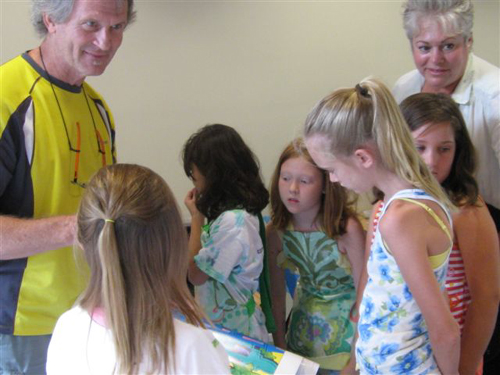
The last session covered the unique features of Charleston architecture, and each camper created a maquette of a Charleston single house, complete with piazzas (or porches) and a landscaped garden. Even during these hectic mornings—gluing shingles, cutting out windows, and designing yards—I could not help but think about how this magical city has intrigued artists for years, and how fortunate it is that we have preserved our history for future generations to enjoy. I was reminded of my time looking at Alfred Hutty’s Charleston prints—I could recognize the scenes he depicted because many of those buildings and gates are still here.
Above: Campers designed Charleston Single Houses.
—Becca Hiester, Volunteer, Gibbes Museum of Art
Published August 11, 2011


